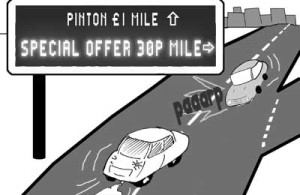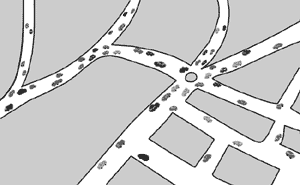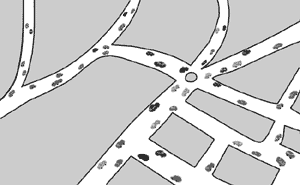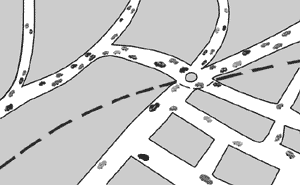
Whatever you may feel on this matter, it is undeniable that the technology will be expensive and complex(1). And then there is the issue of driver distraction(2) as drivers effectively make shopping choices on the move.
The Government seems to be holding serious discussions about such a system, whilst contractors line up(3) to be a part of this expensive publicly funded project. Cheaper and less complex schemes at a local level are a viable alternative, though local authorities are reluctant to act in absence of public support(4) for such schemes.
A zoned system, such as the London Congestion Charge zone, represents a 'second-best'(5) compromise to tracking all cars. This also has a diverting effect to some extent(6) as cars changed routes to avoid being charged. It works best when as many destinations as possible - such as an entire city centre - are inside the charged zone.



"tracking"

"zoning"
Within the zone, patterns of traffic movement are similar to before but at lower levels.
Notes and References
1.
Everyone following the news in the UK will be familiar with stories of technology projects overdue and over budget. For more on this see Corporate Watch's article on the UK Government's IT Procument Record. It should not be controversial to say the simpler, the better.
2.
The RAC Foundation recently criticised road signage policies for overloading drivers with information, in a speech at the "Driver Information" conference in London on February 16th 2006. They also quoted the startling figure that at any one time, 15% of drivers in an urban area are lost! See their press release for more details.
3.
For example Atos Origin, who have composed a 'white paper' on the subject. Atos Origin are IT supplier to the Immigration and Nationality Directorate, who process data on entry and exit at UK borders, and are also open about their interest in being involved with a national ID card register.
4.
York's currently ruling Liberal Democrat party have maintained a strong anti-charging line, in contradiction of statements made at the national level (see also the recently-toned down policy. Their stated reasoning is that York's traffic levels haven't risen by much over the past years. This must in part be due to the already-congested roads. But as Peter Evely of the Council's highway department pointed out in an Evening Press interview, several major new developments are likely to change all that.
Polls on public support for congestion charging by the DfT and Mori in 2003 found public opinion to be finely balanced on the subject. A further MORI poll in 2005 found that opinion had tipped in favour of road pricing, provided that it was revenue neutral.
5.
Not just gratutious use of quotes, but a piece of economics jargon - a system is said to be 'second best optimal' when the ideal solution according to market theory is not possible due to policy contraints. See the Wikipedia definition for more on this. In this case, the optimal solution would be the application of real-time road-use charges to each vehicle depending on the marginal costs of environmental damage and congestion being caused at that precise moment. Such a system would be a major technical undertaking, arguably impossible.
6.
The study "London Congestion Pricing: Implications for Other Cities" (Todd Litman, Victoria Transport Policy Institute, 2006) reports: "Although some diversion occurred the effect appears to be too small to measure." (pg.9) Another paper, "The Development of London Congestion Charging Scheme" (Jaensirisak and Sumalee, The Engineering Institute of Thailand, 2004) quotes an increase in traffic levels orbiting the zone of between 5% and 7%.
| 




